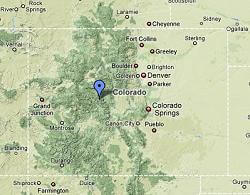Independence Pass is a stunning, meandering stretch of wilderness. It’s one of the most scenic drives in Colorado, the ribbon of highway winding through groves of aspens, big stretches of meadows and up and over great walls of granite. As a climbing area, Independence Pass Rock Climbing boasts relatively short approaches, stellar rock and a large variety of impressive climbs, all in a true alpine setting.
Offering some of the most versatile rock climbing in the country, Independence Pass has nearly a 50/50 split of trad / mixed and sport climbing, with multi-grade, multi-pitch routes and great bouldering, as well.
The Pass is the perfect summer rock climbing destination, with habitually warm and dry days, coupled with striking fall foliage, make for some of the season’s most colorful climbing.

Independence Pass is a stunning, meandering stretch of wilderness. It’s one of the most scenic drives in Colorado, the ribbon of highway winding through groves of aspens, big stretches of meadows and up and over great walls of granite. As a climbing area, Independence Pass Rock Climbing boasts relatively short approaches, stellar rock and a large variety of impressive climbs, all in a true alpine setting.
Offering some of the most versatile rock climbing in the country, Independence Pass has nearly a 50/50 split of trad / mixed and sport climbing, with multi-grade, multi-pitch routes and great bouldering, as well.
The Pass is the perfect summer rock climbing destination, with habitually warm and dry days, coupled with striking fall foliage, make for some of the season’s most colorful climbing.
Climbing Season
The Colorado Department of Transportation closes Highway 82 for the winter, usually just after Halloween. At that time, the highway is gated approximately 4.5 miles east of Aspen and 10.4 miles west of Twin Lakes. The road generally re-opens Memorial Day to accommodate holiday travelers and the start of the summer season.
Year-round climbing can be found on Classy Cliff, Master Headwall and Dragon Rock on the west. On sunny winter days, the Grotto Wall is an easy ski or short snowshoe away. The Dump Wall, Outlook Rock, and Monitor Rock offer year-round climbing access from the east. All other cliffs are climbable as soon as the highway opens.
In summer months the temperatures are mild (70’s and low 80’s), while afternoon thunderstorms are common and ferocious, though often short-lived. In the spring and fall, expect periods of sun, shorter days and occasional bouts of wind and rain, even snow. Be prepared for all weather conditions!
Maps
Independence Pass is bordered by Aspen on the west and Twin Lakes on the east. From Denver, drive I-70 West to 91, south through Leadville to 24 then turn west onto Highway 82 to Aspen (open only during summer months). From Grand Junction drive east on I-70 connecting with Highway 82 at Glenwood Springs.
Camping
Most camping on Independence Pass consists of fee-based camping. Difficult Campground, Weller Campground, Lincoln Gulch Campground and Lost Man Campground are on located the west side of the Continental Divide. Twin Peaks Campground, Parry Peak Campground and Lake View Campground are located east of the Continental Divide. Free camping can be found along Lincoln Creek Road on the west side. Free dispersed camping east of the divide can be found in the Outlook Rock and Dump Wall areas and .5 miles beyond Lake View Campground. See the USDA Forest Service web site www.fs.fed.us for the most up-to-date information.
Environment
Independence Pass is a scenic, clean and fragile wilderness. Low impact / leave no trace policies should be followed.
- Stay on maintained trails as much as possible.
- Dispose your human waste properly. Toilets can be found at all campgrounds. If toilets are unavailable dig a hole at least six inches deep and 200 feet from any water, trails, campsites or base of climbs.
- Pack out all trash!
- Help keep visual impacts to a minimum. Remove all retreat (or bail) slings or biners that you encounter.
Thank you for your help in keeping Independence Pass a beautiful, pristine place to explore!
Style and Standards
Most modern Independence Pass climbs done today started out as chossy, nearly unclimbable rock. Much cleaning is required. This is because most of the natural, ground-up type of line potential has already been done in the 45 year history of Independence Pass route establishment. Depending on the type of route that you want to put up, please abide by the following local standards and traditions of the Pass.
- During the early development of Independence Pass, bold routes were established ground up, many without prior inspection. This means that if you want to put up a run-out, adventure climb with sketchy pro, do it from the ground up, with minimal inspection from above. Others willhave to climb these routes at the same level of boldness as the first ascentionists.
- Due to the nature of the rock, most Pass mixed gear routes were first cleaned then rehearsed on toprope, while trying to leave the rock in its most natural state. Bolts on these routes should be placed with thoughtful discretion allowing for as much natural protection as possible.
- Rap bolted sport routes should be cleaned and have appropriate protection with thought-out clipping positions. The end result should be a perfect sport climb.
Please abide by the following:
- NEVER alter existing routes! If the protection on a particular route does not suit your liking or ability, choose another climb.
- NEVER chip, chisel, glue, or scar the rock.
- Do not squeeze routes in-between other established routes.
- Avoid establishing new climbing on crags immediately above the road. They are a hazard to you and passer-byers.
- All new climbs should include anchors if an obvious or established descent is not present.
History
Independence Pass is a high mountain pass in the Rocky Mountains of central Colorado. The pass is located in the Sawatch Range and connects the towns of Aspen and Twin Lakes. The pass is one of the highest mountain passes in Colorado and offers stunning views of the surrounding mountains and valleys.
The history of Independence Pass dates back to the late 1800s when the area was first explored by prospectors looking for gold and silver. The first recorded ascent of the pass was in 1879 by the famous explorer and geologist John Wesley Powell. Powell was leading a team of surveyors who were mapping the area for the U.S. government.
In the late 1800s and early 1900s, the pass was used by miners and loggers to transport their goods to and from the towns of Aspen and Twin Lakes. The pass was also used by ranchers to move their cattle to summer grazing pastures.
In 1916, the first automobile made the journey over the pass, marking a new era in transportation in the area. The pass was officially opened to automobile traffic in 1923, after years of work to improve and widen the road. The road over the pass was originally a dirt road, but it was paved in the 1950s.
The pass is named after the town of Independence, which was established in 1879 during the boom years of the Colorado silver rush. The town was named after the Declaration of Independence and was one of the first silver mining towns in the area. The town grew rapidly and at its peak had a population of over 1,500 people. However, by the early 1890s, the town had declined and was abandoned.
Today, Independence Pass is a popular destination for tourists and outdoor enthusiasts. The pass is closed during the winter months due to heavy snowfall, but it is open from late spring to early fall. The pass is a popular destination for hikers, bikers, and sightseers who come to enjoy the stunning views of the surrounding mountains and valleys.
In recent years, there has been controversy surrounding the pass due to concerns about the impact of increased traffic on the environment. The Colorado Department of Transportation has worked to address these concerns by implementing measures to reduce traffic and limit the impact of vehicles on the environment.
Overall, Independence Pass is a unique and historic destination that offers visitors a glimpse into the rich history and natural beauty of central Colorado. Whether you are a history buff, an outdoor enthusiast, or simply looking for a scenic drive, Independence Pass is a must-visit destination in the Rocky Mountains.
